Anyone who wants a rifle with more power than a .22 LR but doesn’t want all the noise of a .223 can always choose the .22 Hornet. The idea of a handy centerfire rifle for “survival,” or as a fun gun for the dedicated woods loafer or weekend plinker can be well met by a rifle chambered for this old cartridge. When the Hornet first came out in the early 1930s it was a big hit, and remained so for many years. Today it has a spotty popularity record, generally because many shooters think more is always better, and want a .223. But the Hornet is a lot quieter, and even cheaper than the .223 for the reloader.
Although the Hornet survives today, guns and ammo may not always be easy to find. A recent casual survey of gun shops in a small deer- and elk-hunting community led to exactly one shop out of three having any .22 Hornet ammunition on hand, and that store had but one box.
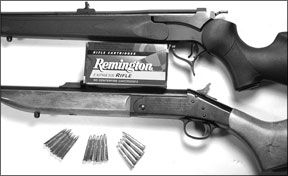
The tiny, rimmed cartridge screams for reloading, not only because ammo might be hard to find. A pound of powder is enough for a thousand reloads. The bullets, primers and a pound of powder will cost about $100-150 total, or about 10 to 15 cents a shot. We just paid $32 for a box of 50 factory loads. That’s 64 cents each. Ouch! So if you own a Hornet, be sure to save your brass. Also, reloading can make the Hornet more versatile than the .22 WMR or the new .17 rimfire, and it delivers a lot more power than either of those.
We recently tested several bolt-action Hornets and fell in love with a CZ that shot circles around its competition. At that time we though a single-shot version might be even handier, and maybe less costly. We wanted to do without a scope, if possible. We can already hear the complaints, that a rifle without a scope is little better than a handgun. But iron sights are hard to beat for lowest cost, plus all-out durability if they are good ones. Never mind that our test rifles can be scoped, they both came to us with iron sights, and we evaluated them that way.
We acquired a New England Arms Handi-Rifle with hardwood stock (SB2-224, about $250 street price) and a Thompson/Center Encore with synthetic stock, which was the least costly version (about $450 street price). The guns had several attributes in common. The controls were few, and were extremely simple. One button or lever opened each rifle. The only safety on each was the hammer. Both had internal blocks that prevented the hammer from striking the firing pin unless the trigger were pressed. We tested them with Remington Express 45-grain PSP ammo and with two of our carefully assembled handloads, one featuring Barnes’ 40-grain Varminator HP bullets (stock no. 22429) and the other with 55-grain Hornady FMJs. We experimented with 75-grain bullets, but the twist rate wouldn’t stabilize them. Here is what we found.
New England Firearms Handi-Rifle No. SB2-224, $250
The Handi-Rifle was true to its name, we thought. We found it easy to carry, pleasant in all its operations, and…well, just plain handy. The ejector worked every time the chamber was opened, which we didn’t really like. The rifle could be opened carefully and loaded silently, without tripping the ejector. Because we are reloaders, we would have preferred a simple, positive extractor over the ejector mechanism. More on this later. The barrel breech was huge in diameter, indicating abundant strength. This rifle is in fact chambered in many calibers including the .35 Whelen, .500 S&W and .45-70, so the design clearly has strength in abundance. As a Hornet, it ought to last forever.
The overall look of the rifle was pleasant, we though. The hardwood (birch?) stock had a well-done, walnut-like finish, a shape suited to iron sights, and a recoil pad that puts those found on Ruger’s heavy-recoiling rifles to shame. It was soft, thick, and comfortable. While not necessary on a Hornet, a pad can keep the gun from slipping and falling. The buttstock was well inletted to match fluted notches in the rear of the action, which ought to help keep things tight over time. There were sling-swivel studs on the butt and forend, but no checkering.
The barrel was matte blued and the receiver was semi-gloss. The trigger guard and forend “iron” or shoe were made of matte-black-finished, high-strength plastic. Lockup was mighty tight, with no looseness or rattling, and it stayed tight throughout our test, though the action was always easy to open and close. The sights were outstanding. The front sight, held to the barrel with an Allen screw, was a ramped, flat-top blade easily seen and undercut to remain that way. The rear sight held a square-cut notch. The rear sight resembled a Micro handgun sight, and was fully adjustable for windage and elevation. The sights came adjusted right on the money. The breech had three drilled and tapped holes for a factory-made, rail-type scope mount that was not included with the rifle. All the fitting throughout the rifle was very well done, we thought.
The forend was removable via a slotted 1/4-20 screw. Don’t lose that screw! Inside the forend we found finish on the wood. With the forend off, the barrel may be easily removed from the action. The mechanism is extremely simple, which is generally a good thing. The receiver appeared to be an investment casting of steel. The small-diameter firing pin was unbushed but spring loaded to keep it out of the way for easy opening of the action. While some of us miss the old top-lever H&R and Iver Johnson actions that closely resemble the Handi Rifle, we can’t fault the simplicity and effectiveness of the push-button opening system.
On the range we had a few failures to eject with some mild, low-pressure handloads. We determined the problem was that our reloaded cases had not been completely full-length sized, which caused a slight stickiness in the Handi-Rifle’s chamber. Polishing the chamber did not help. When we tested again with fully resized cases the problem went away. This problem did not occur with the T/C.
The Handi-Rifle has no positive primary extraction. It has a spring-loaded lifter that, if all goes well, starts the case moving out of the chamber and prepares it for ejection. We don’t like this spring-loaded extraction system, some of us having had long experience with break-open firearms, the good ones of which will positively lift a stuck case every time the gun is opened, without fail unless the rim is ripped off in a really bad situation. We conclude we’d take a 100-percent-functioning positive-lifting extractor over this spring-loaded design any day. This didn’t make us reject the Handi-Rifle, but made us wary.
We liked the simple, handgun-like sights of the Handi-Rifle much more than those on the T/C. They were easy to see and simple to align, and our groups showed no vertical stringing. The hammer is either fully cocked or fully down. You can’t see the rear sight with the hammer down. As noted, the gun cannot fire from a blow on the hammer unless the trigger is held back. It is impossible to hold the trigger back until the hammer has been cocked. There is no need for any extra safety, we thought, and it is possible to carry the rifle empty and to load it silently when required. We found the stock to be very comfortable over the machine rest, notably more so than the T/C, which had a higher comb set up for a scope. The NEF’s trigger pull was excellent, and the action speed seemed lively. There were no failures to fire.
Thompson/Center Arms Encore No. 3853, $450
The composite-stock Encore had iron sights, and like the Handi-Rifle, had very simple controls. Squeeze the trigger guard to break open the rifle. Whatever is in the chamber is then brought slightly out of the breech for easy extraction by the fingers. The hammer was the rebounding type that moves rearward once the trigger is released, and then a block is interposed so the gun can’t fire. There was no half-cock position, nor was one needed. Unlike the Handi-Rifle, which had its sights obscured by the lowered hammer, the T/C Encore had a lower hammer, most likely with scoping in mind for those (most of us) who don’t like hammer spurs off to the side. With the right scope choice it just might be possible to slip the thumb onto the hammer to cock it, and thus avoid those off-to-the-side hammer spurs.
The stock was matte black and had impressed checkering that did some good. There were sling studs and a recoil pad. The metal was polished and nicely blued, with a decorative area of matte black low on the receiver. Both the Handi-Rifle and the T/C Encore can be fitted with auxiliary barrels in different calibers. There are some limits to the NEF setup as to what barrels are available, but not many with the T/C. Two screws secured the forend to the barrel. To our surprise the forward screw was not fastened to the barrel. Why it hadn’t fallen out remains a mystery. With the forend off it is necessary to push out a large pin, and then the barrel can be removed from the receiver. Don’t lose the two screws or the pin!
Both the Handi-Rifle and the T/C appear to have their bottom lugs welded to the barrels. The old “chopper lump” of earlier single and double rifles, which had the lug forged integral to the barrel, cannot be considered for modern firearms, more’s the pity. Of course that was a more costly system, and these modern guns seem to be more than adequately strong. Like the NEF, the T/C had an investment-cast receiver. The metalwork and fitting were more than adequate for the task at hand but not particularly refined.
There were large gaps between rifle and forend, and between buttstock and action that were, we thought, uncalled for. You could see light right through the rifle from top to bottom at both the forend and around the action sides. The gap between the forend and action was over an eighth of an inch. That means you can easily pack the gun full of dirt, or rain, or snow. Also, the buttstock came up far too high where it met the action, as though the stock would shrink, over time, to fit. But all you’ll have for the life of the rifle is an ill-fitting stock that won’t win many admirers.
We didn’t care for the iron sights here, not compared with those on the NEF. The front was a very visible white bead that did not give good elevation or windage control. The rear was a folding unit with a small sliding insert that had a small U-notch. As is usual with this combination, it’s hard to tell where you ought to hold the front bead. All our groups showed vertical stringing, which essentially destroyed them, though the groups were usually narrow enough. The poor sights didn’t permit us to get anywhere near all the rifle had to offer. Better sights would be in order, we thought, if we owned this one. Clearly, especially in light of its rather high cheekpiece, the Encore wanted a scope. The action was drilled and tapped for a scope base, which again was not provided with the rifle. The T/C was a touch lighter than the Handi-Rifle, and had a trigger that was about equally good. Some of our shooters didn’t care for the stock shape at the wrist, but others liked it just fine.
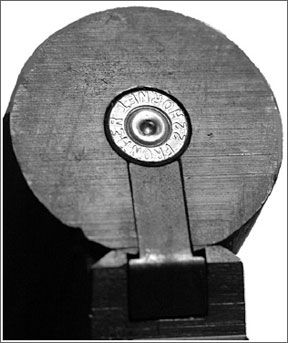
On the range the Encore had a hard time shooting as well as the Handi-Rifle with these round-on-round sights. If the T/C had sights equal to those on the NEF we’re sure we could have shot it better. Our best group was again made with one of our handloads, this time the 55-grain FMJ, which made a 0.7-inch cluster. The Remington factor fodder recorded a one-inch cluster, but most groups were badly vertically strung to almost two inches. There were no functional problems with the rifle at all. The operations were all clean and easy to use, so it was easy to see why the T/C’s have made a lot of friends along the way.
Gun Tests Recommends
New England Firearms Handi-Rifle, $250. Our Pick. We thought the Handi-Rifle’s groups were, on the whole, small enough, the very best being 0.8 inches at 50 yards with our 40-grain handload. Average groups for all loads were in the 1.5- to 2-inch area for five shots at 50 yards. While a scope would probably improve group sizes, it would make the rifle a lot less handy. Of course the owner’s specific end use for the rifle will determine the optic requirements, but we would never carry this rifle scoped. We look at the Handi-Rifle as a fun gun that can do some hunting under specific circumstances. It’s also excellent for training. An aperture sight would be nice, but it would have to be mounted to the stock to get it back far enough.
All in all, we thought the Handi-Rifle was useful for plinking and perhaps some hunting, but it was not a specific varmint-type rifle. It’s in the fun realm where it shines. If this rifle weighed a pound or more less, it’d be even more handy and more likely to go along on walks in the woods. That’s entirely possible because the Handi-Rifle is also available in two models with good-looking synthetic stocks, and one of them is a super-light version. There’s even one with a short synthetic stock and light barrel for young shooters that weighs just over 5 pounds.
Thompson/Center Arms Encore No. 3853, $450. Conditional Buy. We concluded the T/C Encore is intended for scope use, and with its lousy iron sights and higher price is a poor second to the Handi-Rifle as they both come out of the box. Our best groups indicated a tendency for the rifle to shoot very well indeed, which is common with T/C firearms. We could not prove it with these poor sights, which was one of the intents of this comparison. We suggest the makers actually try their rifles with the iron sights they put on them (T/C is by no means alone here), and they would quickly stop putting such garbage on their firearms. Buy the Encore if you intend to scope it. We thought it was sturdy and ought to last a long time, and of course it can be easily changed into different calibers with the purchase of a barrel.
But avoid it if you want a knock-about Hornet with iron sights. There are many stock and finish options available for the Encore, including pistol-type stocks and short barrels to turn it into a single-shot handgun or a shotgun.


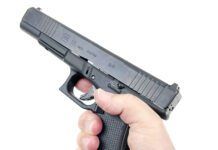
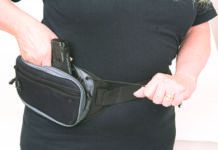

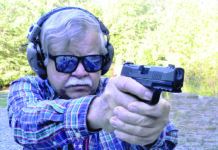



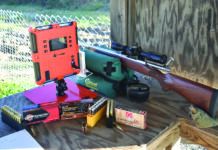

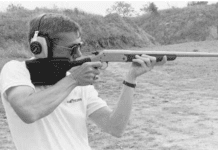







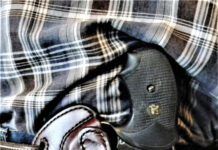

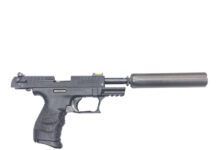



Very well written article.
I have the NEF Handi in .22 Hornet, black stock, stainless bull barrel, railed and scoped. It’s awesome accurate, zeroed at 50 yrds, produces sub MOA with Hornady factory loads. Fun at range. Old timers tell me they used them for turkey. In a SHTF situation, I think it will keep him-migratory Canada geese on my table. Bought at pawn shop in 2017 for $225.
“Non-migratory” (pest) Canada geese. Sorry about autocorrect.
Hi, Does anyone know of any H&R Handi Replacement Barrels for sale in 22 hornet?
Does anyone have a 22hornet for sell??